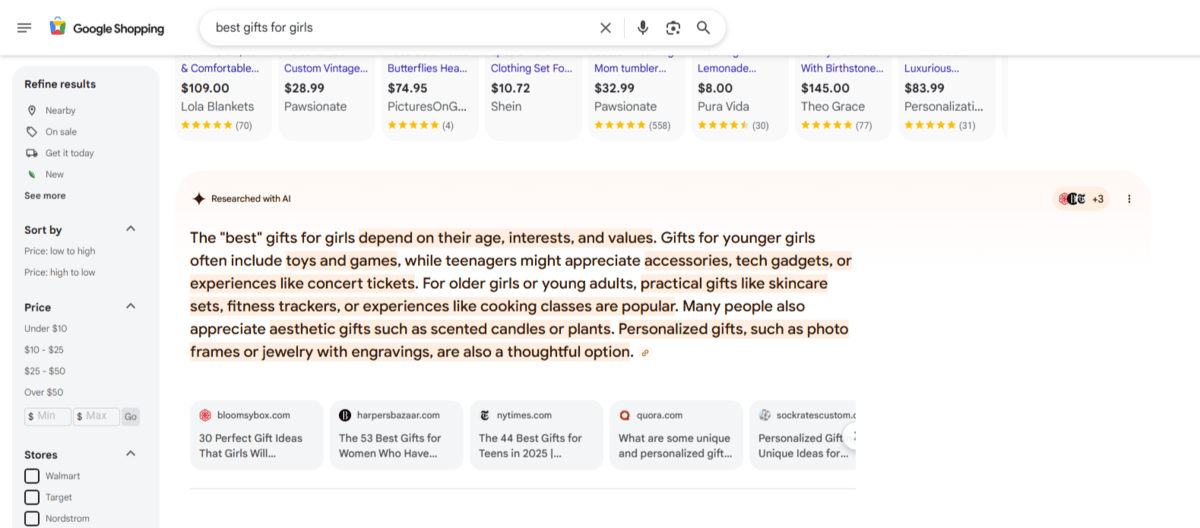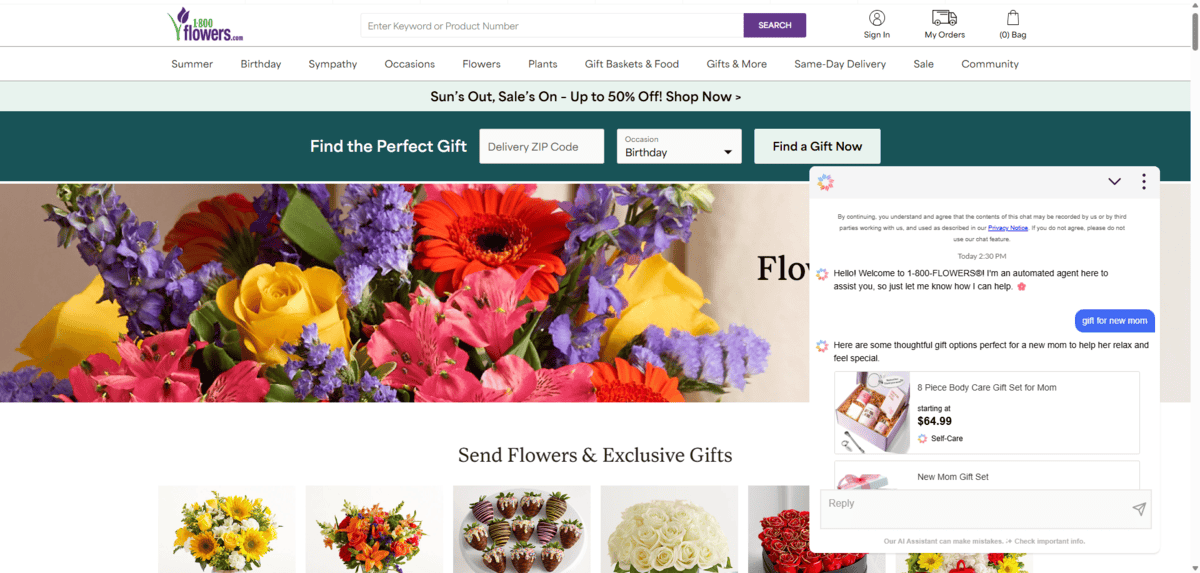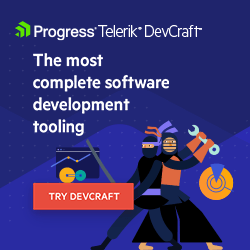Preparing for an AI-powered Holiday Shopping Season

Salesforce predicts that artificial intelligence is going to alter consumers’ holiday shopping habits in 2025. To help ecommerce brands keep up, digital pros may need to adjust their SEO strategy, incorporate AI assistive technology into their websites or apps, and so on.
A new report out of Salesforce suggests that this holiday season will be a little different from years past. Why? Because of the proliferation of artificial intelligence.
For years, we’ve talked about ways to leverage AI to improve productivity and outcomes from the backend. Now we need to look at how AI is changing the way consumers do things on the frontend and then adjust our strategies accordingly.
Considering how lucrative the holiday shopping season is, this means that ecommerce digital teams need to start preparing early for these changes. In this post, we’ll look at some of the points addressed in this Salesforce report and what you can do with them.
Adjusting Your Ecommerce Strategy for AI
Using insights from the Salesforce 2025 Holiday Predictions report, here are three ways to adjust your marketing and development strategy ahead of the 2025 holiday shopping season:
1. Study AI Search Results & Optimize Your Content Accordingly
According to a Salesforce Consumer Shopping AI Trends report from 2025, 39% of all consumers use AI to discover products online. When you look at Gen Z shoppers alone, that number shoots up past 50%.
The report also mentioned findings from a Capgemini survey. Not only are consumers using AI-powered search recommendations to discover new products, many are moving away from traditional search engines. About two-thirds of millennial and Gen Z shoppers now use generative AI tools like ChatGPT instead of search engines.
So, what exactly should you do about this?
The holidays are a great time to introduce your brand to new shoppers and drive them to your store with popular products and attractive deals. In the past, you could use a combination of organic and paid strategies like:
- SEO
- SEM (Google Ads)
- Social media posts
- Social media ads
- Retargeting (email and ads)
Having a shop optimized for Google search—especially Google Shopping results—was especially critical to a brand’s success.
But now you have to think about AI. If anywhere from 40% to 70% of shoppers use AI for product discovery, your marketing strategy needs to change as does your content.
For starters, spend some time interacting with AI. Go to Google Shopping and do a search for a product or category that you sell (or that’s worked for bringing in new traffic in the past).

Have a look at the AI recommendations. Specifically, look at the wording of the AI response as well as the wording of the product (or article) names.
Then click into the product recommendations. Compare each product page. How are they structured? How long are the product descriptions? What other key details appear above the fold? Is there anything that stands out about the shopping experience?
What may have worked for you in organic or paid Google search before, may not be effective with AI. So, you’re going to need to reoptimize your ecommerce content so that it is more appealing to AI.
This will improve the chances of your products showing up in AI-powered search recommendations.
Do the same thing with ChatGPT or your preferred generative AI tool. See if there’s any overlap between the response you get there and what you found in your search engine. Ideally, you’ll find similarities with phrasing, word count, product positioning and so on, so you can optimize once for all AIs.
Another thing to pay attention to is what sources the AIs use or recommend to decide which products are best.
For instance, in the screenshot above, two of the six sources come from Quora. You may not be able to get The New York Times or Harper’s BAZAAR to do a write-up on your store or products, and your own store might not have as much authority. However, you might be able to draw attention to your brand by providing useful responses and recommendations in public forums like Quora and Reddit.
If this isn’t part of your marketing strategy already, it’s something to think about doing in anticipation of the holiday season.
2. Add an AI Assistant to Your Shopping Experience
According to Salesforce, 39% of online shoppers engage with an AI chat assistant these days. What’s more, 30% of brick-and-mortar shoppers use AI chat when they’re in retail stores. Millennials and Gen Zers rely on it even more, with 40% of them using an AI assistant while shopping in person.
When asked about holiday shopping, 59% of respondents said they plan on using AI chat for gift recommendations. The trust level appears to be relatively high, too. Only 21% of those surveyed said they wouldn’t trust gift recommendations from an AI assistant.
Now, many consumers may just use ChatGPT, Grok or whatever their preferred AI tool is when they’re looking for gifting recommendations. But that’s really only going to work on a broad level, before they’ve even got a brand in mind.
What will these people do once they discover your store?
The best that ChatGPT and the like may be able to do is give shoppers general gift ideas instead of pointing them to specific products. It would need to be well-trained on your sitemap and sales data in order to do that. So, ideally, your website or app should have its own AI chat assistant.
1-800-Flowers, for instance, has a chatbot that does more than offer prewritten prompts you so often find in AI chat:

Here I’ve asked the chatbot about a “gift for new mom.” In response, the bot has given me four links to related products.
As the message at the bottom of the chat widget says:
“Our AI Assistant can make mistakes. Check important info.”
I’d say that two of the four recommended products are relevant to my query while the other two aren’t so much. But that’s still a lot more helpful and convenient than having to search through an entire store’s inventory on my own.
And that’s the thing. At this point, users are accustomed to getting fast and relevant answers to their questions because of the proliferation of generative AI tools. When they do online shopping, many won’t want to spend the time researching when they’ve had an AI assistant helping them in so many other aspects of their lives.
Because of this, your site or app needs to be able to deliver a comparable experience. To do this, your chat assistant should offer:
- Natural-sounding responses
- Instant recommendations
- Numerous, relevant recommendations
- Real-time (and maybe even proactive) guidance as they shop
Interestingly enough, I struggled to find AI ecommerce assistants while researching this point. Even websites that previously had AI chatbots (until recently) didn’t have any trace of them. So if you’re not sure if you want to add a chatbox to your site or app, or don’t have enough time to implement one prior to the holidays, perhaps instead focus on the search experience.
Offering an AI-powered search experience could also be beneficial for shoppers. While it might not give them that conversational interaction, it can offer trusted and personalized recommendations based on their activity and shopping history.
3. Automate and Streamline Customer Support with AI
One of the reasons why I may not have found AI chat to be as prevalent in my research is because I’m looking at the surface level of the shopping experience. Not every ecommerce brand may find it beneficial to invest in visitor-facing AI chat assistance. However, many may find it useful to employ the technology to help triage customer interactions.
According to Salesforce, 35% of retail companies are planning to use agentic AI for the 2025 holiday shopping season.
How does this differ from the chatbots we see on the frontend of ecommerce sites or apps?
| AI Chatbot | Agentic AI |
|---|---|
| May offer preselected options or open-ended questions to users | May offer preselected options or open-ended questions to users |
| Responds to user prompts with set answers | Responds to users in a smart and dynamic way |
| Users must initiate engagement | AI can proactively offering support and suggestions |
| Strict constraints on how it can respond | Can adapt to user input |
| Typically provides simple recommendations or redirects user to live support | Able to analyze, respond and initiate some actions based on user input |
While an AI chatbot can provide some light assistance and guidance to new customers, agentic AI is what creates a game-changing experience for converted (or almost converted) customers. Instead of providing a small handful of prewritten responses, agentic AIs work a lot like ChatGPT does, giving in-depth and personalized responses.
Think of it like the level of attention and care you’d give to different leads or prospective customers.
For example, you’d offer light, gentle guidance to a top-of-funnel lead who’s only just found out about your brand and has no idea what they want to buy, if anything. That’s what an AI chatbot would do. It’s a no-frills technology that adds just a little something to the shopping experience.
On the other hand, you’d offer more pointed guidance and more greatly emphasize value to a bottom-of-funnel lead who’s pretty much made up their mind. That’s what agentic AI would do.
As holiday shoppers get deeper into that sales funnel and close in on conversion, that’s where agentic AI will be the most handy. You could use it to automate and streamline customer tasks:
- Comparing two similar products
- Setting up a customized product
- Booking an experience
- Scheduling a delivery
- Getting support post-sale with fulfilment or a return
There are a number of benefits to going the route of agentic AI.
For starters, it tends to be less disruptive to early shopping experiences. Instead, it steps in when shoppers would benefit from more hand-holding and, most importantly, where that sort of service could encourage more of them to convert, spend more and return at a later date.
Also, think about the time it’ll free up for your support team. AI agents will never fully replace human ones. However, they can handle common customer interactions and questions, so that team members can focus on providing white-glove support to loyal customers who want and need it.
Wrapping Up
AI is set to transform the 2025 holiday shopping experience.
For customers, it will make buying gifts for loved ones (and themselves) much easier. It may even enhance the online shopping experience, depending on how retailers put the technology to use.
For ecommerce companies and retailers, AI transformation can go either way. For brands that adopt the technology and adapt to it, this could prove to be a much more successful holiday sales season. For brands that don’t, they might get left behind as product discoverability drops and users opt to buy from brands offering the AI-powered support they’ve grown used to.
Like with everything in marketing, you have to consider your audience. While AI may be hugely important to younger generations, it isn’t as much with other consumers. So, have a look at your audience data and talk to some of your customers before making any sweeping changes to your strategy. You may find that major changes and expenditures aren’t needed and instead you only need to make smaller, yet still highly impactful changes.

Suzanne Scacca
A former project manager and web design agency manager, Suzanne Scacca now writes about the changing landscape of design, development and software.

